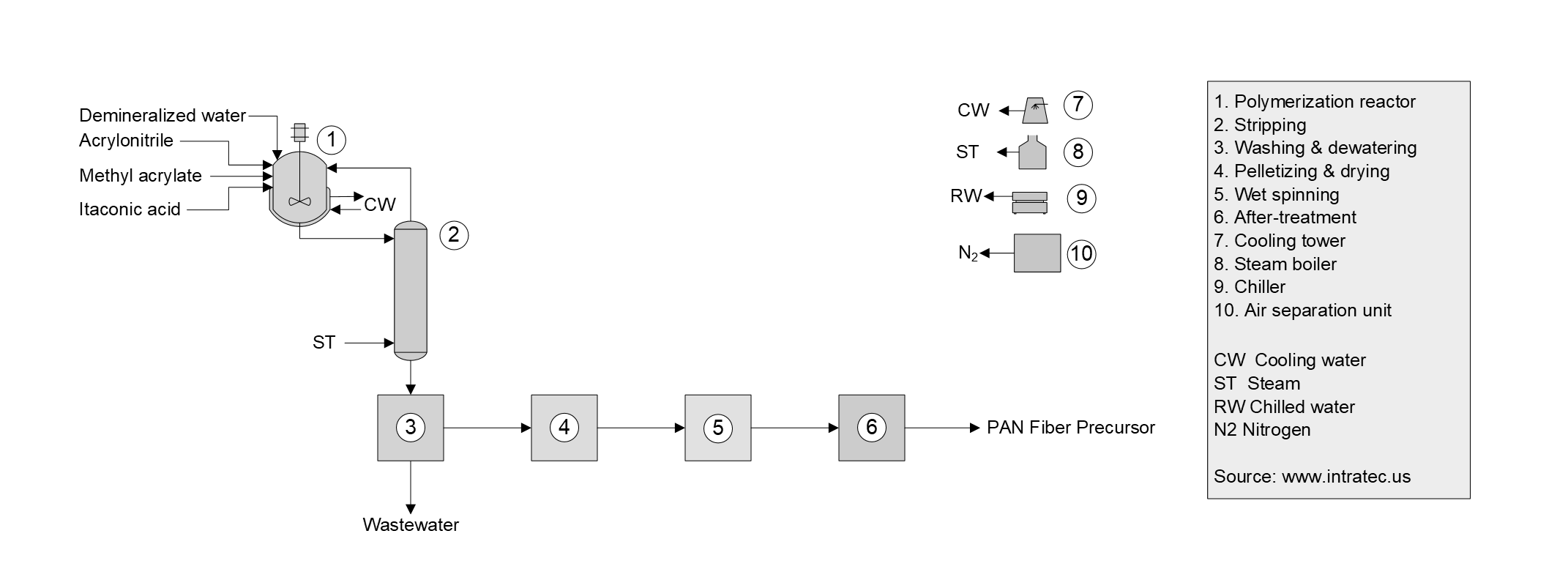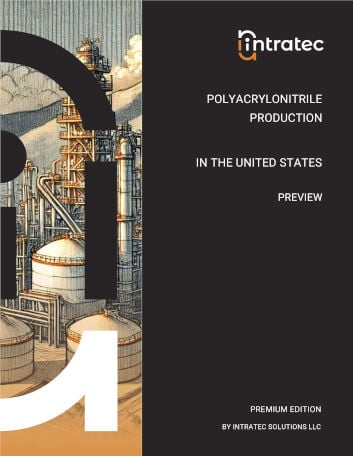Commodity Production Costs Report
Polyacrylonitrile Production
Polyacrylonitrile Plant Capital & Operating Cost Analysis | United States | Q2 2025
This report presents a techno-economic analysis of Polyacrylonitrile (PAN) Precursor production in the United States via aqueous dispersion polymerization of acrylonitrile with methyl acrylate comonomer followed by transformation steps to become a fiber.
The report provides a comprehensive study of Polyacrylonitrile production and related Polyacrylonitrile production cost, covering three key aspects: a complete description of the Polyacrylonitrile production process examined; an in-depth analysis of the related Polyacrylonitrile plant capital cost (Capex); and an evaluation of the respective Polyacrylonitrile plant operating costs (Opex).
The Polyacrylonitrile production process description includes a block flow diagram (BFD), an overview of the industrial site installations, detailing both the process unit and the necessary infrastructure, process consumption figures and comprehensive process flow diagrams (PFD). The Polyacrylonitrile plant capital cost analysis breaks down the Capex by plant cost (i.e., ISBL, OSBL and Contingency); owner's cost; working capital; and costs incurred during industrial plant commissioning and start-up. The Polyacrylonitrile plant operating costs analysis covers operating expenses, including variable costs like raw materials and utilities, and fixed costs such as maintenance, labor, and depreciation.

The process under analysis comprises four major sections: (1) Polymerization; (2) Pelletizing; (3) Wet spinning; and (4) After-treatment.
Polymerization. Initially, a mixture of acrylonitrile, methyl acrylate and itaconic acid is fed continuously to a continuous stirred-tank reactor (CSTR) where the polymerization takes place. The reaction is initiated by feeding aqueous solutions of potassium persulfate (oxidizer), sulfur dioxide (reducing agent), ferrous iron (promoter), and sodium bicarbonate (buffering agent). The heat of polymerization is removed by water circulated in a reactor jacket. Next, an iron-chelating agent is added to the reactor overflow, where it acts as a chain stopper for the polymerization. The reactor overflow, an aqueous slurry of polymer particles, is fed to a monomer-separation column, in which unreacted monomer is steam-stripped from the slurry. The monomers recovered are returned to the reactor.
Pelletizing. The polymer is pelletized, dried, ground and then converted to fiber through subsequent steps involving physicochemical transformations, as briefly described below.
Wet spinning. The polymer is dissolved in dimethylformamide (DMF), forming a dope. The dope is pumped through a spinneret into a precipitating bath, for the coagulation of the solution thread line into a highly swollen gel yarn.
After-treatment. The fiber is washed in countercurrent by hot water, for the removal of the solvent. The fiber is then stretched while passing over rollers with adjustable speed. The stretching imparts fiber strength. Subsequently, silicone is applied as an aqueous emulsion to the fiber, to act as lubricant and antistatic agent. The fiber passes through drum dryers for water removal. Tows are crimped by means of a stuffer box crimper. Crimping provides interflament cohesion across the tow and facilitates subsequent handling. Then the fiber is fed to an autoclave for a relaxation process that reduces the tendency for fibrillation and increases the fiber dimensional stability.
Report in PDF Format
Download & Explore Anytime
Access in Various Devices
Print & Read Comfortably
Share With Co-workers
Up-to-date Report
Professional report based on Q2 2025 economic data, ensuring timely evaluations.
Multiple Use Cases
Ideal for investment screening, feasibility studies, cost estimates, and research planning.
Proven Methodology
Developed using a consistent methodology honed over a decade, ensuring reliable cost analyses.
Report Editions
Content Highlights
Plant Capital Cost Summary
Summary outlining the capital cost required for building the Polyacrylonitrile production plant examined.
Plant Capital Cost Details
Detailing of fixed capital (ISBL, OSBL & Owner’s Cost), working capital and additional capital requirements.
Plant Cost Breakdowns
Breakdown of Polyacrylonitrile process unit (ISBL) costs and infrastructure (OSBL) costs; plant cost breakdown per discipline.
Operating Costs Summary
Summary presenting the operating variable costs and the total operating cost of the Polyacrylonitrile production plant studied.
Operating Cost Details
Detailing of utilities costs, operating fixed costs and depreciation.
Plant Capacity Assessment
Comparative analysis of capital investment and operating costs for different Polyacrylonitrile plant capacities.
Production Process Information
Block Flow Diagram, descriptions of process unit (ISBL) and site infrastructure (OSBL).
Process Consumptions
Raw materials and utilities consumption figures, by-products credits, labor requirements
Process Diagrams
Process flow diagrams (PFD), equipment list and industrial site configuration
Could Not Find the Report You Need?
Obtain a Bespoke Report
Get a report targeting the process in which you are interested
See Offer Details
Understand Bespoke Reports and how you can easily order them
Check Editions & Pricing
Complete a brief form and see a quotation for your Bespoke Report
Other Related Production Cost Reports

Acrylonitrile Production from Propane
This study presents the economics of Acrylonitrile production via propane ammoxidation. The process is similar to the one proposed by PTT Asahi Chemical (PTTAC), consisting in the reaction of propane with ammonia, producing Acrylonitrile. Acetonitrile and hydrogen cyanide are produced as by-products. The analysis assumes a plant located in the United States,
Details: 200 kta United States-based plant | Q2 2025 | 107 pages | Issue B | From $799 USD

Acrylonitrile Production from Propylene (Fluidized Bed Ammoxidation)
This report presents the economics of Acrylonitrile production from chemical grade (CG) propylene in the United States. The process reviewed is a propylene ammoxidation technology using fluidized bed reactor, in which propylene reacts with ammonia, producing Acrylonitrile, and generating acetonitrile and hydrogen cyanide as by-products.
Details: 300 kta United States-based plant | Q2 2025 | 107 pages | Issue A | From $799 USD

Carbon Fiber Production from PAN Fiber
This report provides a techno-economic analysis of a typical Carbon Fiber production process starting from polyacrylonitrile (PAN) fiber in the United States. In this process, PAN fiber is first stabilized. The stabilized PAN passes then through carbonization, surface treatment and sizing, before being winded.
Details: 2.5 kta United States-based plant | Q2 2025 | 107 pages | Issue A | From $1,199 USD

Methyl Acrylate Production
This report presents the economics of Methyl Acrylate production from acrylic acid and methanol in the United States, via a direct esterification process similar to the Synthomer process. The esterification is conducted in a fixed bed reactor, packed with an ion-exchange resin that is used as strong acid catalyst.
Details: 30 kta United States-based plant | Q2 2025 | 107 pages | Issue A | From $799 USD

Itaconic Acid Production
This report approaches an economic analysis of Itaconic Acid production from dimethyl succinate (DMS) and formaldehyde in the United States. In this process, Itaconic Acid is produced via a citraconate intermediate in a catalytic condensation reaction. Succinic acid is generated as a by-product.
Details: 20 kta United States-based plant | Q2 2025 | 107 pages | Issue A | From $999 USD
+800 Reports Developed, Targeting +250 Commodities
Vast Report Library
858 independent and up-to-date reports examining embryonic and established production processes.
Free Sample Reports
Quickly understand the structure and depth of content of our professional reports.

